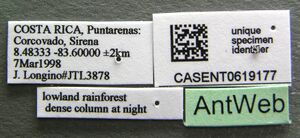Neivamyrmex postcarinatus
| Neivamyrmex postcarinatus | |
|---|---|

| |
| Scientific classification | |
| Kingdom: | Animalia |
| Phylum: | Arthropoda |
| Class: | Insecta |
| Order: | Hymenoptera |
| Family: | Formicidae |
| Subfamily: | Dorylinae |
| Genus: | Neivamyrmex |
| Species: | N. postcarinatus |
| Binomial name | |
| Neivamyrmex postcarinatus Borgmeier, 1953 | |
This species is only known from queens and/or workers and has yet to be associated with males.
Identification
Transverse carina present near junction of dorsal and posterior faces of propodeum.
Distribution
Latitudinal Distribution Pattern
Latitudinal Range: 18.18333333° to -13.83333333°.
| North Temperate |
North Subtropical |
Tropical | South Subtropical |
South Temperate |
- Source: AntMaps
Distribution based on Regional Taxon Lists
Neotropical Region: Costa Rica, Mexico, Panama (type locality).
Distribution based on AntMaps
Distribution based on AntWeb specimens
Check data from AntWeb
Countries Occupied
| Number of countries occupied by this species based on AntWiki Regional Taxon Lists. In general, fewer countries occupied indicates a narrower range, while more countries indicates a more widespread species. |

|
Estimated Abundance
| Relative abundance based on number of AntMaps records per species (this species within the purple bar). Fewer records (to the left) indicates a less abundant/encountered species while more records (to the right) indicates more abundant/encountered species. |

|
Biology
Jack Longino: I know this species from two collections, one from Sirena in Corcovado National Park, the other from Hitoy Cerere Biological Reserve. The collection from Hitoy Cerere was a column on vegetation at night.
Castes
Images from AntWeb
   
| |
| Worker. Specimen code casent0619177. Photographer Will Ericson, uploaded by California Academy of Sciences. | Owned by JTLC. |
Nomenclature
The following information is derived from Barry Bolton's Online Catalogue of the Ants of the World.
- postcarinatus. Neivamyrmex postcarinatus Borgmeier, 1953: 43, figs. 34, 35 (w.) PANAMA (Barro Colorado I.).
- Type-material: 34 syntype workers.
- Type-locality: Panama: Canal Zone, Barro Colorado I., 21.ii.1946, no. 93, 8.iii.1946, no.97, 18.iii.1946, no. 100, and 16.i.1948, no 141 (T.C. Schneirla).
- Type-depository: MZSP.
- Wheeler, G.C. & Wheeler, J. 1984: 272 (l.).
- Status as species: Borgmeier, 1955: 395 (redescription); Kempf, 1972a: 158; Watkins, 1976: 12 (in key); Bolton, 1995b: 291.
- Distribution: Panama
Description
References
- Albuquerque, E., Prado, L., Andrade-Silva, J., Siqueira, E., Sampaio, K., Alves, D., Brandão, C., Andrade, P., Feitosa, R., Koch, E., Delabie, J., Fernandes, I., Baccaro, F., Souza, J., Almeida, R., Silva, R. 2021. Ants of the State of Pará, Brazil: a historical and comprehensive dataset of a key biodiversity hotspot in the Amazon Basin. Zootaxa 5001, 1–83 (doi:10.11646/zootaxa.5001.1.1).
- Borgmeier, T. 1953. Vorarbeiten zu einer Revision der neotropischen Wanderameisen. Stud. Entomol. 2: 1-51. (page 43, figs. 34, 35 worker described)
- Borgmeier, T. 1955. Die Wanderameisen der neotropischen Region. Stud. Entomol. 3: 1-720 (page 395, see also)
- Wheeler, G. C.; Wheeler, J. 1984a. The larvae of the army ants (Hymenoptera: Formicidae): a revision. J. Kans. Entomol. Soc. 57: 263-275 (page 272, larva described)
References based on Global Ant Biodiversity Informatics
- Borgmeier T. 1953. Vorarbeiten zu einer Revision der neotropischen Wanderameisen. Studia Entomologica 2: 1-51.
- Borgmeier T. 1955. Die Wanderameisen der neotropischen Region. Studia Entomologica 3: 1-720.
- Borowiec M. L. 2016. Generic revision of the ant subfamily Dorylinae (Hymenoptera, Formicidae). ZooKeys 608: 1–280.
- Dattilo W. et al. 2019. MEXICO ANTS: incidence and abundance along the Nearctic-Neotropical interface. Ecology https://doi.org/10.1002/ecy.2944
- Del Toro, I., M. Vázquez, W.P. Mackay, P. Rojas and R. Zapata-Mata. Hormigas (Hymenoptera: Formicidae) de Tabasco: explorando la diversidad de la mirmecofauna en las selvas tropicales de baja altitud. Dugesiana 16(1):1-14.
- Fernández, F. and S. Sendoya. 2004. Lista de las hormigas neotropicales. Biota Colombiana Volume 5, Number 1.
- Fichaux M., B. Bechade, J. Donald, A. Weyna, J. H. C. Delabie, J. Murienne, C. Baraloto, and J. Orivel. 2019. Habitats shape taxonomic and functional composition of Neotropical ant assemblages. Oecologia 189(2): 501-513.
- Goitia W., and K. Jaffe. 2009. Ant-Plant Associations in Different Forests in Venezuela. Neotropical Entomology 38(1): 007-031.
- Longino J. et al. ADMAC project. Accessed on March 24th 2017 at https://sites.google.com/site/admacsite/
- Vásquez-Bolaños M. 2011. Lista de especies de hormigas (Hymenoptera: Formicidae) para México. Dugesiana 18: 95-133

